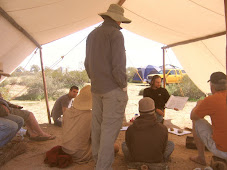 |
| Rotting meat in mason jars. |
Aajonus Vonderplanitz believed if raw meat was healthy, then rotten or "high" meat is probably even healthier. The Inuit traditionally enjoyed rotted flesh as part of their diet, and so did many cultures around the world. I was insanely curious about this. Would it feel good in my body? Or would I get really sick? So I began making "high" meat -- filling mason jars with sliced up beef and airing them out every few days. Oddly enough, the rotten smell that developed over a few weeks began to please my senses. It smelled good, it looked good -- I couldn't wait to eat it. Then the day came when it was ready. So I took a jar filled with rotting, slimy meat outside, opened it, and reached in for my first taste of this supposed health elixir. I loved it. Weird, I know. It just tasted way good for some reason. Although the little white beads on the meat that had developed over the weeks somewhat disturbed me. Were these some kind of worm eggs or something? Was I ingesting parasites? Well, even if I was, Mr. Vonderplanitz assured me in his book that they would merely detox my body and consume my unneeded intestinal wastes. Win-win for me and my little worm buddies. They get to eat and I get better! Oh lord, I have done some interesting things in my life, and this one is up there on the list.
Again, much to my surprise, the most shocking thing that happened was -- well, that nothing happened. I remained healthy and feeling quite good overall on my raw and rotten diet. After a few months of this "primal diet," I encountered something even more alluring in my continual research: the raw paleo diet. I joined a forum where there were a handful of folks experimenting with this diet -- consisting of nothing but raw meat and fat -- and experiencing great results. (Apparently these folks still exist.) Their stance on eating mostly organ meats made a lot of sense to me, as this was where the most nutrients exist, and if my goal was optimal health, well then I wanted all the nutrients I could get, gosh darn it! I began the raw paleo diet with enthusiasm, picking up raw liver and raw beef fat from the butcher at a local organic foods store. Damn, did that stuff taste good to me. I swear, at the time, the liver tasted like chocolate and the beef fat tasted like ice cream. Soon I was gorging on kidneys, spleens, tongues, and any other raw offal I could get my grubby little hands on.
Pretty soon I realized that zero-carb, raw paleo was the way to go (naturally, right?). I felt great -- well, for the most part. My back pain was pretty much gone at this point, but I seemed to have developed hard stools from the sudden transition to zero carbs + zero fiber. Not only that, but I began to see fat chunks in my stool, which, at first I thought were gall stones until, ahem, closer inspection. There also was this "heavy" feeling in my body at times, like I was walking underwater. Also, another problem --chest pain -- came about when I started to try to eat only one large meal a day, as some folks on the raw paleo forum were suggesting as the optimal eating pattern. It would sort of come and go and actually wasn't too bad ... until I tried to do some push-ups -- ouch. I thought I was having a heart attack. I calmed myself and decided that maybe it was just some kind of strain. It hurt horribly for two days.
 |
| The Bear |
I have been eating the natural human dietary regime for over 47 years now. I do not eat anything whatsoever from vegetable sources. The only things veggie I use are spices. My diet is usually 60% fat and 40% protein by calories. I used to eat 80/20 when younger and about twice as much quantity of meat also, but that seems too much energy at my age, which is 71- even though I am very active. I think the body actually becomes more efficient with energy as you age, but I have no way of proving it true. Otherwise, my body today is very like it was at the age of 30. I figure most of what we call 'aging' is due to insulin damage to the collagen and other body structures. No carbs = no insulin. I don't heal quite as fast when injured as I did as a youngster, however. But I have few wrinkles, and my skin is still strong and elastic.
The guru had arrived. Responses came pouring in. The Bear had answers for everything. His healthy 47 years of experience with the zero-carb "regime" proved that modern humans could live well on such a diet without problems. There was a very strong divide on the forum: some loved him and others thought he was full of crap. One guy even started a dedicated blog on the "Zero Carb Path." The Bear validated everything I believed at the time, and I followed guru's advice on eating and living well. I still had the aforementioned problems with my gut, but decided that I felt better than any other time in my life, so I continued on "the path."
The saga continues in Part 5, coming soon.



